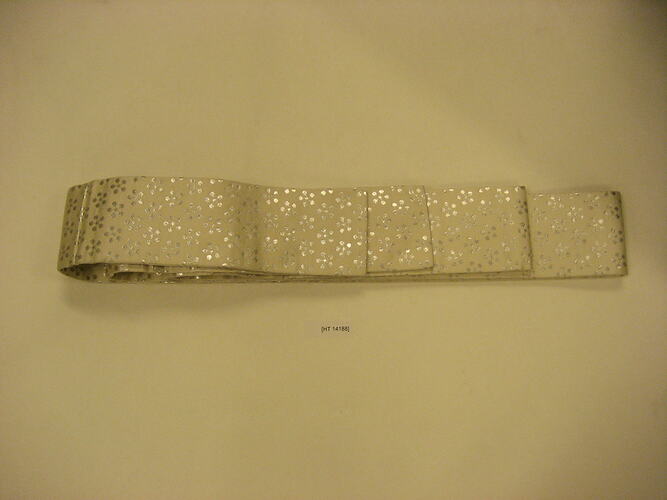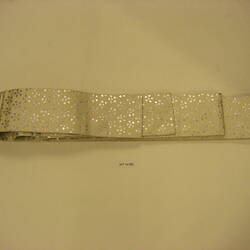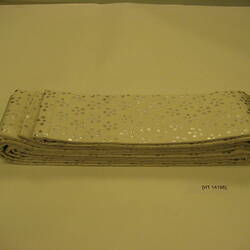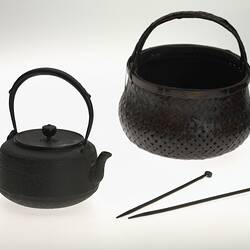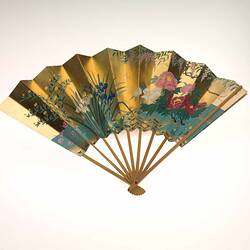Summary
This is a white obi with a silver threaded snowflake design. Made in the 1960s, it was worn by Masumi Hiraga Jackson for Noh Theatre dancing with the purple kimono [purple kimono made by Masumi's eldest sister with purchased fabric, with the family crest at the back below the collar] and the grey Hakama (long pleated culotte-like skirt worn over the top of the kimono). The women in Masumi's family have woven and sewn kimonos since the early 20th century. Kimonos are traditional Japanese garments, worn by men and women. Kimonos vary in style, colour, pattern and fabric depending on the occasion and the wearer. Masumi's kimonos hold special meaning for her, as mementoes of her homeland and as cultural artefacts which she wears socially and for performances. Noh is an important form of classical musical drama performed in Japan since the 14th century. The principal actor, and sometimes minor actors wear masks. All performers, including the chorus singers and musicians, carry fans. Masumi Hiraga studied Noh Theatre at Toyo University in the 1950s and continues to learn and practise the art at the Hosho School of Noh in Japan. She performs in Japan and Australia.
Masumi Hiraga Jackson was born in Nirasaki, Japan in 1935, one of ten children. Her mother Kino was a skilled weaver who wove and sewed silk kimono, a highly regarded skill. Masumi studied at universities in Tokyo (Japanese cultural studies) and Canberra (English and linguistics) and in 1984 married an Australian. She immigrated to Melbourne in 1985 but sadly her husband died two years later. Masumi decided to remain in Australia and immersed herself in traditional Japanese cultural practices such as Noh theatre, Ikebana and Shimotske paper doll-making. She performs and instructs these art forms in Australia and overseas, and returns to Japan every year to see her family, undertake Ikebana lessons, practise her Noh performance and to purchase materials for doll-making.
Physical Description
Obi comprised of a rectangular length of white textile, with a silver threaded 'snowflake' design. Worn with purple kimono by the donor.
Significance
The significance of this item is its place within a collection which represents the personal and cultural value of maintaining cultural and artistic traditions within a new environment. The act of migration has profound implications for both immigrant and receiving country, with many migrants actively finding ways to introduce their cultural practices in an environment unfamiliar with such activities. This collection can help to explore the successful shift in Australian government policies from the cultural assimilation of the 1950s to the more broadly embracing multicultural policies from the 1970s. Moreover, its significance also lies in the intrinsic artistic value of the finely crafted Shimotsuke dolls, and the cultural heritage value of the collection of kimono.
More Information
-
Collection Names
-
Collecting Areas
-
Acquisition Information
Donation from Mrs Masumi Hiraga, 21 Mar 2007
-
Place & Date Made
-
Past Owner or User
-
Past Owner or User
Mrs Masumi Hiraga, Melbourne, Greater Melbourne, Victoria, Australia, 1985-2007
-
Classification
-
Category
-
Discipline
-
Type of item
-
Fully Extended
399.5 cm (Length), 10 cm (Width), 2.5 cm (Depth)
-
Overall Dimensions - Folded
35 cm (Length), 10 cm (Width), 6.5 cm (Height)
Length of sleeve only.
-
Keywords
Japanese Communities, Japanese Culture, Performances, Theatre, Theatrical Performances
